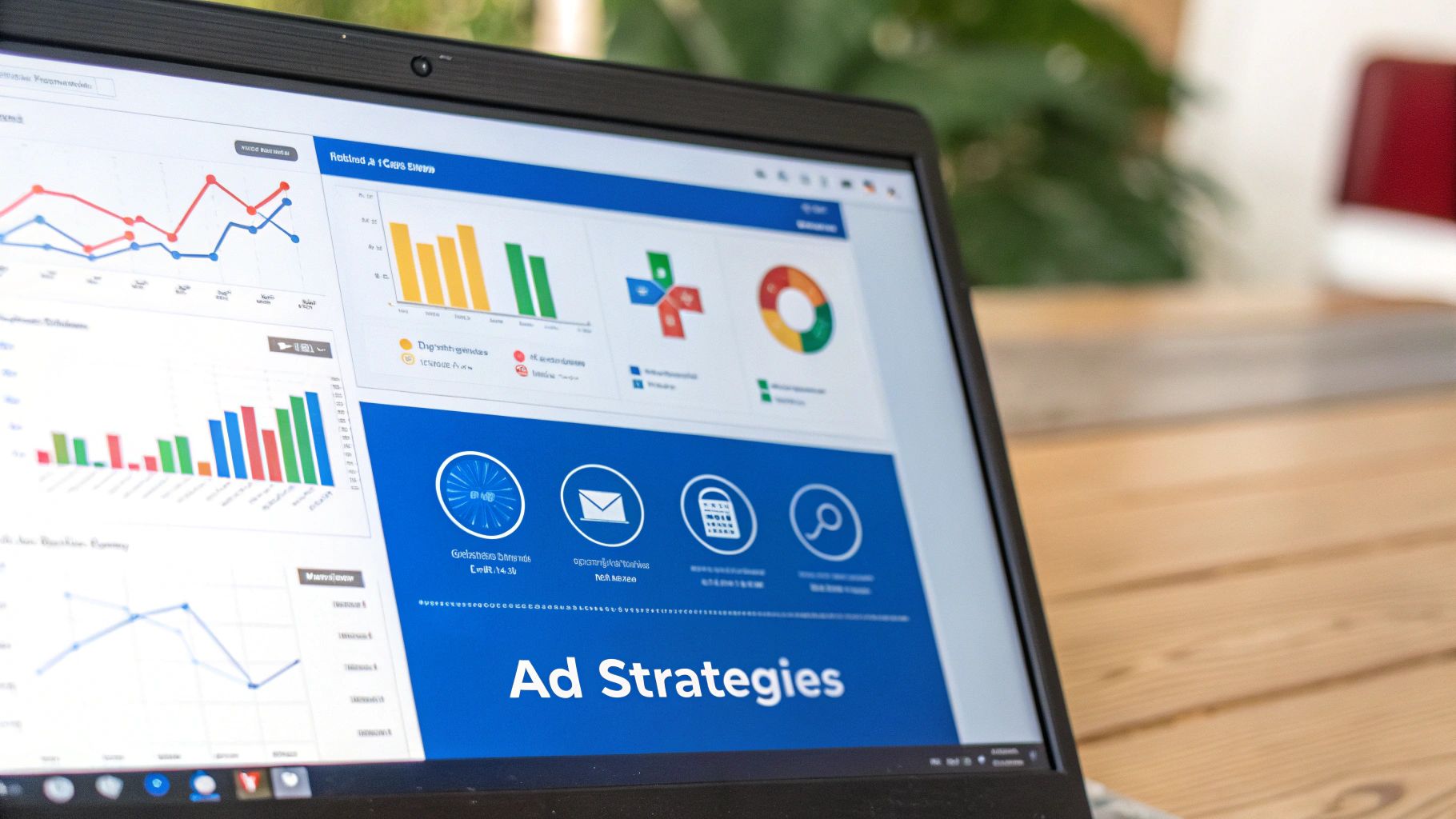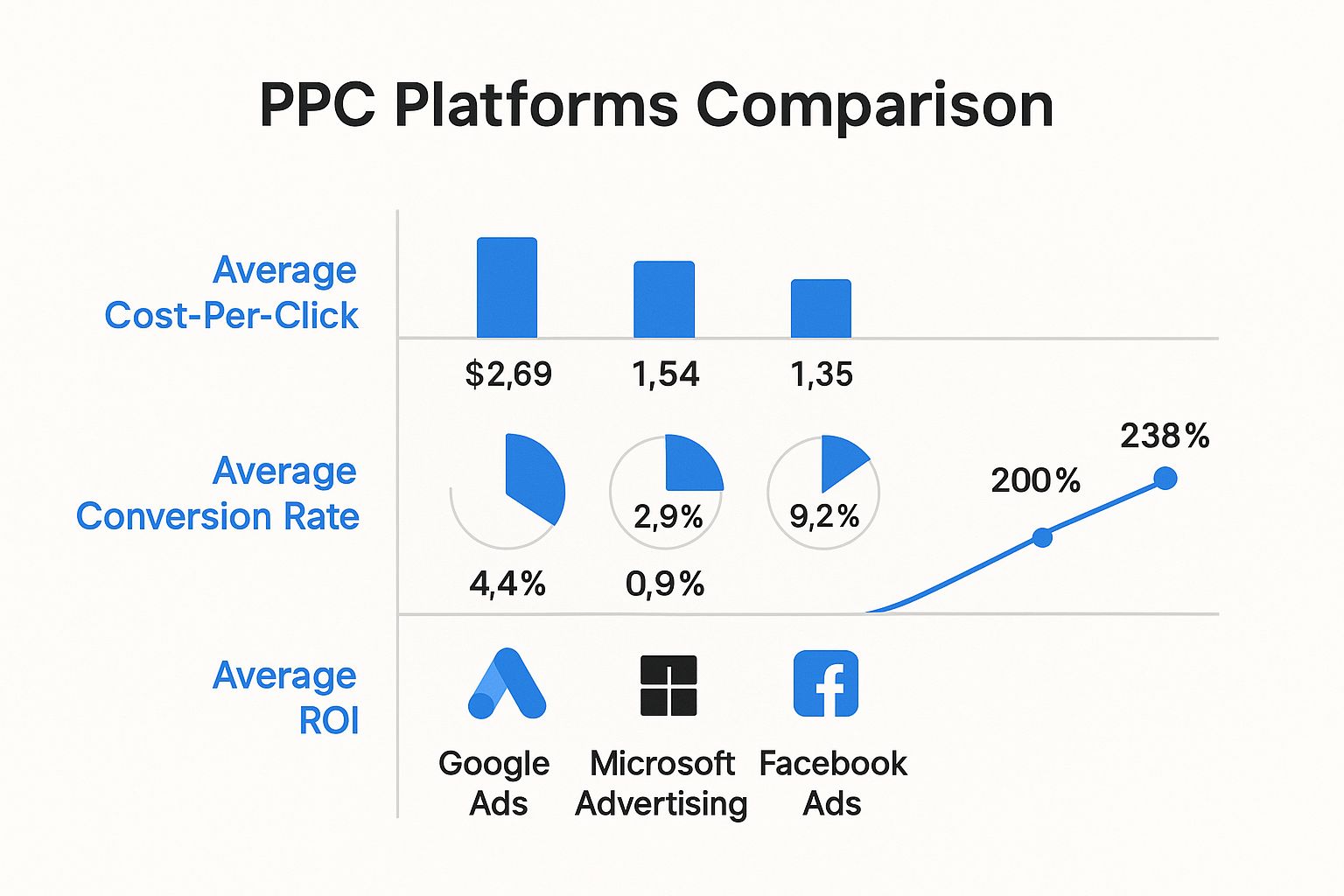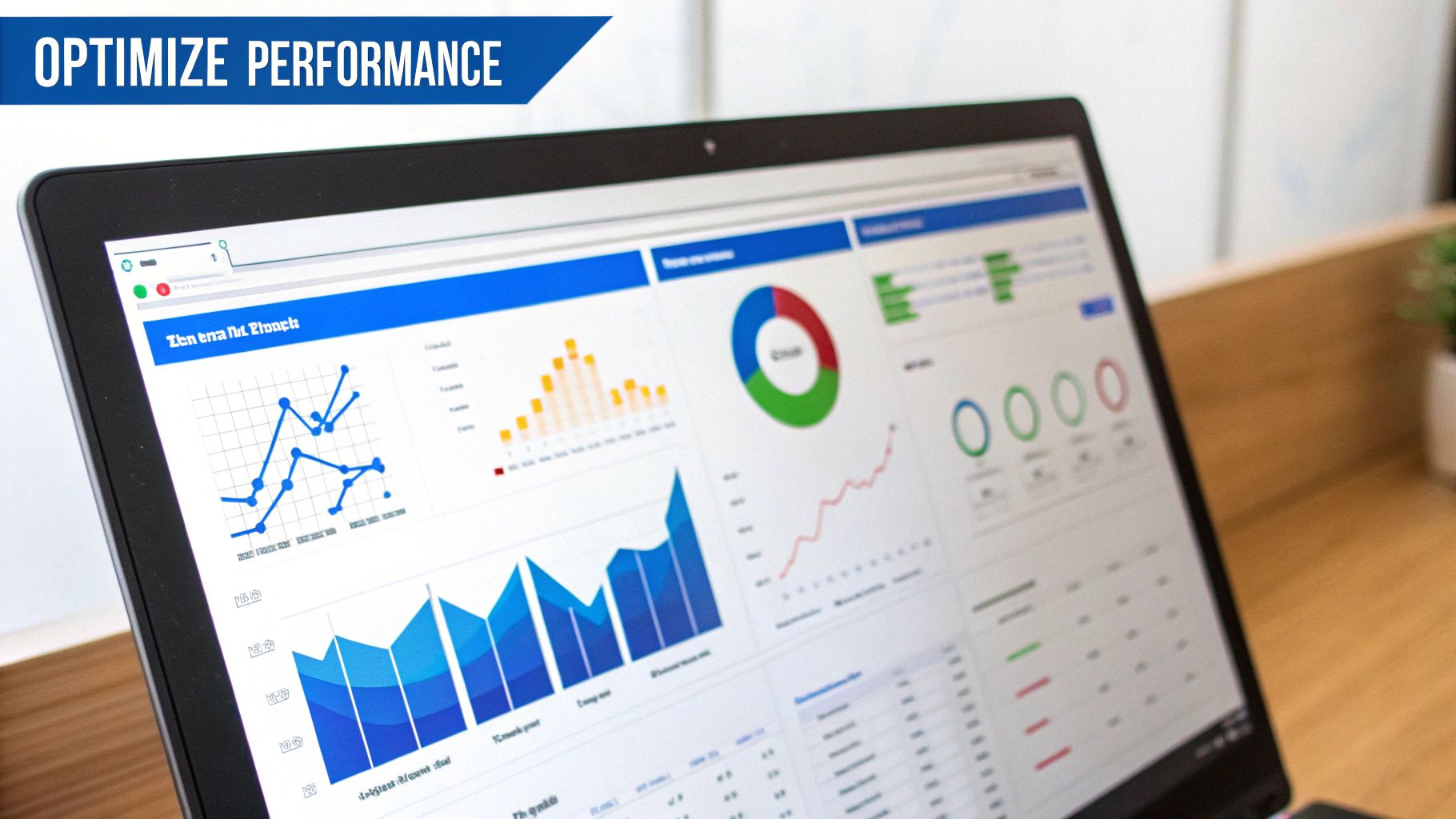PPC leads are the engine for so many growth-hungry businesses. These aren't just random website visitors. They are people who saw your paid ad, were interested enough to click, and decided to raise their hand. That signal of intent is what makes them an essential piece of any smart digital marketing strategy.
Before you even think about spending your first dollar on a click, you need to lay the groundwork. This is what separates the pros from the advertisers who just toss money at keywords and hope something sticks.
This initial planning phase is all about defining what a "quality lead" actually means for your specific business—not just collecting a name and an email. Getting this right from the start prevents you from wasting a ton of money and sets you up for a campaign that actually turns a profit.
The whole game is built on one simple idea: a well-planned campaign delivers a strong return. It’s why marketers love this channel. A staggering 93% consider PPC either 'effective' or 'highly effective,' and 84% have seen good results from their campaigns. The numbers back it up, too. On average, companies earn back $2 for every $1 invested in Google Ads, with some campaigns hitting an incredible 800% ROI.
Your first move isn't keyword research—it's customer research. A lead is completely worthless if it's the wrong person.
So, who are you actually trying to reach? Are you selling to enterprise clients or small business owners? What are their job titles? What industry do they work in? What's their company size? Answering these questions first is the single best way to avoid burning through your budget on clicks from people who could never, ever become your customer.
For example, a SaaS company selling project management software to construction firms shouldn't just target "project management software." They should define their ideal lead as a "Project Manager" or "Operations Director" at a construction company with 50+ employees. That level of clarity instantly sharpens every other decision you'll make, from the words you use in your ads to the story you tell on your landing page.
Guess what? Your competitors are already out there spending money to get the same PPC leads you're after. This is great news. It means you can learn from their experiments and find the gaps in their game plan. Don't just look at who is bidding on your keywords; dig into what they're saying and offering.
A huge mistake I see advertisers make is getting obsessed with keyword bidding. The real competitive edge is almost always found in better messaging and a more persuasive offer. Your goal isn't just to show up in the search results—it's to give people a much better reason to click your ad and convert.
Finally, it's time to connect your strategy to actual numbers. The most common question is, "How much should I spend?" but the better question is, "What is a new customer actually worth to my business?" This is where knowing your Customer Lifetime Value (CLV) is a game-changer.
If one customer is worth $5,000 over their lifetime, you can obviously afford to spend more to acquire them than if they're only worth $500. This simple math helps you set a target Cost Per Acquisition (CPA).
From there, you can work backward to set a realistic budget and define your Key Performance Indicators (KPIs). Instead of just tracking the basic Cost Per Lead (CPL), focus on a metric that really matters, like Cost Per Sales Qualified Lead (SQL). This makes sure your marketing spend is tied directly to the outcomes your sales team—and your bank account—truly care about.
Before you jump into building campaigns, it's worth running through a final check to make sure all your strategic pieces are in place. This simple exercise can save you a lot of headaches down the road.
Essential Pre-Campaign Planning Checklist
Planning AreaKey ActionWhy It MattersLead DefinitionCreate a detailed Ideal Customer Profile (ICP) including title, industry, and company size.Prevents wasted ad spend on unqualified clicks and aligns marketing with sales.Competitive IntelAnalyze competitor ad copy, landing pages, and offers.Helps you identify gaps and opportunities to create a more compelling message.Unique OfferDevelop a lead magnet or offer that stands out from what competitors are doing.Gives prospects a stronger reason to choose you over everyone else.Budget & ROICalculate your Customer Lifetime Value (CLV) to set a target Cost Per Acquisition (CPA).Ensures your campaign is designed for profitability from day one.KPI SelectionDefine primary KPIs beyond CPL, such as Cost Per SQL or conversion rate.Focuses optimization efforts on metrics that directly contribute to revenue.
Nailing these foundational elements is what separates campaigns that deliver a handful of leads from those that become reliable, scalable engines for business growth. With this groundwork complete, you're ready to start building.

Getting the ad click is just the first step. The real challenge in generating high-quality PPC leads is creating a seamless experience between your ad and your landing page. Think of them as partners in a delicate dance; if one stumbles, the whole performance falls apart. A brilliant ad that sends traffic to a confusing landing page is a complete waste of money. And a perfect landing page will never get seen if its ad fails to grab the right attention.
Pay-per-click has become a non-negotiable part of modern marketing, with around 80% of businesses now using it to fuel their growth. This isn't surprising when you consider that 65% of consumers click on ads when they're actively looking for something. The goal is to turn those clicks into leads, and while the average PPC campaign converts at 2.55%, that’s still about 50% better than the conversion rate from organic traffic.
Your ad copy has two critical jobs: pull in the right people and gently push away the wrong ones. If your language is too generic, you'll get clicks from users who were never a good fit to begin with. The trick is to use language that speaks directly to your ideal customer's problems and what they're trying to achieve.
Your ad copy is like a specific radio frequency—only those with the right receiver will hear the message clearly. For example, instead of a broad headline like "Project Management Software," get more specific: "PM Software for Construction GCs." That headline instantly qualifies your audience, speaking directly to a general contractor while filtering out marketing agencies or software developers who might also be searching for PM tools.
Use your description lines to zero in on specific pain points or outcomes. Highlight a key benefit that solves a major headache for your target audience.
This approach ensures the people who click are already pre-qualified. They know what you offer and have a genuine interest in your solution. As you build out your campaigns, remember to experiment with different formats; for instance, these video strategies for lead generation can add another powerful tool to your arsenal.
Once someone clicks your ad, the landing page must continue the conversation without skipping a beat. The most important thing here is message match. The promise you made in your ad needs to be immediately and obviously delivered on the landing page. If your ad promised a "free cost calculator," the headline on your landing page better be "Free Construction Cost Calculator."
A landing page is not your website's homepage. Its only job is to convert a visitor for one specific offer. Any extra navigation, links, or competing calls-to-action are just exit ramps, distracting the user and destroying your conversion rate.
To build a landing page that actually converts, focus on these core components:
Building pages like this from scratch can feel like a lot, but you can learn more about https://www.cometly.com/google-ads-lead-generation/how-to-create-high-converting-landing-pages to get a head start. The goal is to remove every ounce of friction and make it incredibly easy for a qualified visitor to become a valuable lead for your business.

Attracting a steady stream of high-quality PPC leads starts long before anyone even sees your ad. It begins with a rock-solid strategy to find and connect with the right people using the right keywords. The goal isn't just to get clicks—it's to get clicks from people who are actively searching for the exact solution you provide.
This means shifting your mindset from broad, "spray and pray" targeting to surgical precision. It’s about more than just picking popular terms. You need to dig deep into user intent, structure your campaigns for maximum relevance, and layer in sophisticated audience signals.
Get this right, and your ads become a welcome answer to a user's problem, not just another interruption.
Let's be clear: not all keywords are created equal. Some signal casual browsing, while others practically scream, "I'm ready to buy." The secret to generating valuable PPC leads is focusing your budget on keywords that show high commercial intent. These are the phrases people type when they're deep in the buying funnel and looking to make a decision.
For instance, a search for "what is CRM" is purely informational. But someone searching for "best CRM for small business" or "Salesforce alternative pricing" is much closer to pulling the trigger. By concentrating on these high-intent terms, you ensure your ad spend is working to attract traffic that’s far more likely to convert.
Put yourself in your customer's shoes. What problem are they trying to solve right now?
These types of keywords attract users who have already identified their need and are now actively evaluating their options. This is precisely the moment you want your ad to show up.
Once you've got your list of high-intent keywords, the next move is organizing them into tightly themed ad groups. This is one of the most overlooked—and most critical—parts of a winning campaign. A well-structured account leads to higher Quality Scores, which Google rewards with lower costs-per-click and better ad positions.
The rule of thumb is simple: each ad group should contain a small, closely related set of keywords. Then, all the ads within that group should be written specifically for those keywords.
A classic mistake is dumping hundreds of keywords into a single ad group and serving one generic ad. This creates a huge disconnect between what the user searched for and the ad they see, which tanks click-through rates and brings in poor-quality leads.
Imagine you run a property management company. Instead of one giant ad group for "property management," you should create separate ones:
This tight structure ensures maximum "message match"—a powerful signal to both users and Google that your ad is highly relevant. To really nail this, it helps to get a deeper understanding of keywords and their match types and how they all work together.
Keywords get you in the game, but layering in audience targeting is how you win it. Platforms like Google Ads let you show your ads not just to people searching for a term, but to people who also fit a specific profile. This is where you can get incredibly precise and dramatically boost the quality of your PPC leads.
For a B2B SaaS company, this could mean layering on an "In-Market: Business Services" audience. For an ecommerce store, you might add a "Luxury Shoppers" affinity audience. This filtering ensures you’re reaching people who are not only searching for your solution but are also part of your core demographic.
Some powerful audience layers to experiment with include:
By combining sharp keyword strategies with these powerful audience layers, you transform your PPC campaigns from a wide fishing net into a powerful magnet for your ideal customers.
Here's a truth every seasoned PPC pro knows: launching a campaign isn't the finish line. It's the starting block. The real work of generating a steady stream of high-quality PPC leads happens in the day-to-day grind of optimization. This is where you roll up your sleeves and turn an average campaign into a lead-gen machine through smart, data-driven tweaks.
Think of it this way—your initial launch is based on your best-educated guesses. Ongoing optimization is where you systematically replace those guesses with hard data, refining your strategy one test at a time. It’s this continuous improvement loop that separates the campaigns that fizzle out from those that deliver profitable, long-term growth.
One of the most powerful—and surprisingly underused—tools in your arsenal is the search term report. This report gives you a direct look at the exact queries people typed into the search bar right before clicking your ad. It's a goldmine. You're literally reading your audience's mind.
Your job is to regularly dig through this report to spot two things: irrelevant searches that are torching your budget, and new, high-intent keyword opportunities you might have missed.
For example, a company selling "CRM software for real estate agents" might discover they're getting clicks from searches like "free CRM for students" or "CRM jobs." These clicks are expensive and will never turn into qualified PPC leads. By adding terms like "students" and "jobs" to your negative keyword list, you instantly plug the leak and stop wasting money. This simple, recurring task is one of the fastest ways to boost your campaign's ROI.
The data below shows how key performance metrics can vary wildly across different PPC platforms, which should inform where you focus your optimization efforts.

This just hammers home why ongoing optimization is so critical. What works like a charm on one platform might need a total overhaul on another to get the same quality of leads.
The secret to massive, long-term improvement isn't one big, dramatic change. It’s a series of small, incremental wins that compound over time. You get there through methodical A/B testing—testing one variable at a time to see what truly resonates with your audience.
You should always be testing something. Always. Whether it's your ad copy, your landing page headline, or the color of your call-to-action button, continuous testing ensures you’re always moving toward a better-performing campaign.
Here are a few high-impact elements to start testing right away:
Don't get discouraged by failed tests. A test that doesn't produce a "win" is still incredibly valuable—it tells you what doesn't work, which is just as important as knowing what does. Every test is a new piece of data to guide your next move.
Your bidding strategy is the engine of your campaign. It controls how much you pay for clicks and is a powerful lever for influencing lead quality. There's no single "best" strategy here; the right choice depends on your campaign's maturity, conversion volume, and ultimate goals. There's a ton of information out there on this, but a good starting point is to learn more about how to optimize your Google Ads campaign and the different bidding features available.
To help you decide, here’s a quick comparison of the two main approaches.
This table breaks down common PPC bidding strategies to help you choose the right approach for your lead generation goals.
Bidding StrategyBest ForProsConsManual CPCNew campaigns, small budgets, or when you need maximum control.Granular control over bids; protects budget while learning.Time-consuming; can't react to real-time signals.Target CPAMature campaigns with at least 30-50 conversions/month.Leverages machine learning; automatically optimizes for conversions at a target cost.Requires sufficient conversion data; less direct control.Maximize ConversionsCampaigns where the main goal is lead volume, regardless of cost.Drives the most conversions possible within your budget.Can lead to high CPLs if not monitored closely.Enhanced CPC (eCPC)A hybrid approach for those not ready for full automation.Automates bid adjustments for clicks likely to convert.Still requires manual base bids; less powerful than full automation.
Ultimately, the goal is to move from manual to automated bidding as your campaign gathers enough data. For new campaigns with limited history, Manual CPC (Cost-Per-Click) gives you maximum control. You set the bid for each keyword yourself, allowing you to be aggressive on your most valuable terms and conservative on others. It’s a hands-on approach that's perfect for learning the ropes and protecting your budget early on.
Once your campaign has a steady flow of conversions—I’m talking at least 30-50 per month—you can confidently hand the reins over to an automated strategy like Target CPA (Cost-Per-Acquisition). You just tell the ad platform how much you're willing to pay for a lead, and its algorithm will adjust bids in real-time to hit that target. This frees you up to focus on the big-picture stuff, like ad creative and landing pages, knowing the bidding is being handled efficiently to meet your lead quality goals.

A lead isn't just a form submission; it's a potential customer. The real value of your PPC leads only comes to light when you can draw a clear, measurable line from their initial click all the way to a closed deal. This means you have to tear down the wall that so often stands between marketing efforts and sales outcomes, creating a single, unified system that tracks the entire customer journey.
Without this connection, marketing ends up operating in a vacuum. You might be celebrating vanity metrics like form fills, but the sales team is left struggling with a list of low-quality contacts. The goal here is to build a powerful feedback loop where sales data directly fuels and sharpens your PPC strategy, making sure every dollar you spend on ads is generating real revenue.
If you're only tracking website form submissions, you're only seeing a fraction of the story. A genuinely valuable lead might skip the form entirely. They might see your ad, pick up the phone, and call your business directly. Or maybe they engage with a live chat agent on your landing page. If you're not tracking these high-intent interactions, you’re missing a huge chunk of data about what’s actually working.
To get the full picture, you have to broaden your definition of a conversion. Thankfully, modern ad platforms and analytics tools let you track a much wider range of actions that signal real interest.
Here are the essential conversions you absolutely need to be tracking:
The real magic happens when you integrate your PPC data directly with your Customer Relationship Management (CRM) system. This is the bridge that finally connects marketing’s world to sales’ reality. When a new lead from a PPC campaign lands in your CRM, it shouldn't just be a name and an email address—it should come packed with a wealth of data.
This data should include things like:
By piping this data straight into your CRM, you give your sales team critical context. They’ll instantly know what problem the lead was trying to solve, which allows them to tailor their follow-up for a much more relevant and effective conversation.
This integration transforms your CRM from a simple contact database into a powerful marketing intelligence tool. It’s the foundation for understanding which parts of your PPC account are generating junk leads and which are delivering revenue-ready prospects. If you want to go deeper on this, there’s a great guide on how to measure marketing attribution that breaks down the core concepts.
Once your CRM is enriched with all that juicy PPC data, you can finally create the ultimate feedback loop. Now, your sales team can tag leads based on their quality—labeling them as a Marketing Qualified Lead (MQL) or a Sales Qualified Lead (SQL), for instance. They can also track which leads turn into appointments, which become opportunities, and which ones ultimately become paying customers.
This sales outcome data can then be passed back to your ad platforms. This is what allows you to optimize your campaigns not just for lead volume, but for actual business results. You can literally tell Google or Facebook to find more people just like the ones who signed contracts, not just the ones who filled out a form. This is how you stop wasting budget on keywords and audiences that produce low-quality PPC leads and double down on what truly drives profitable growth.
Even when you have a killer strategy, the world of PPC leads can throw you some serious curveballs. You launch a campaign, things are looking good, and then… questions pop up. Challenges you didn't anticipate start to surface. It's just part of the game.
This is where we get into the nitty-gritty. We're moving past the textbook theories to tackle the real, everyday questions that come up when you're in the trenches managing campaigns. From budget blowouts to sudden drops in lead quality, my goal is to give you the practical answers you need to make smarter, faster decisions.
It's one of the most frustrating feelings for a marketer. Your campaign is humming along, generating solid PPC leads, and then—seemingly out of nowhere—the quality plummets. When this happens, it's rarely one single thing. It’s usually a perfect storm of subtle shifts in the ad auction.
Here are the first places I always look:
Your first move should be to dive into your auction insights report. See if any new competitor domains have popped up. At the same time, scour your search term reports for an influx of garbage queries that are somehow slipping past your negative keywords. This detective work is essential to find the root cause.
I’ve learned that a sudden drop in lead quality is almost always a signal to go back to basics. Re-examine your ad copy. Are you still speaking directly to your ideal customer? Your ad copy acts like a filter; sharp, specific messaging repels the wrong people and attracts the right ones.
Ah, the million-dollar question. The truth is, there's no magic number. Instead of asking, "how much should I spend," the better question is, "what is a lead actually worth to my business?" Your budget should be tied directly to your business economics—specifically, your Customer Lifetime Value (CLV).
It's a simple bit of math. If you know an average customer is worth $5,000 over their lifetime and your sales team closes 1 out of every 10 qualified leads, then a single qualified lead is worth $500 to your business. Boom. Now you have a ceiling for your target Cost Per Acquisition (CPA) and can set a budget that's baked in profitability.
For brand new campaigns where you have no data, a good rule of thumb is to budget enough to get at least 100-200 clicks. This gives you just enough data to start seeing what’s working and what isn’t.
This is the classic "quality vs. quantity" debate. While it's tempting to chase a firehose of leads to keep the pipeline full, the smarter, more profitable play is almost always to focus on quality.
Think about it: one highly-qualified lead who's ready to talk to sales is infinitely more valuable than 50 unqualified leads that just waste your sales team's time and morale.
Focusing on quality just makes your entire operation more efficient. Sales cycles get shorter. Conversion rates go up. And your marketing spend becomes way more effective. This is especially true for B2B and SaaS businesses with complex sales processes. If that's you, our guide on lead generation for B2B SaaS digs much deeper into these specific challenges.
At the end of the day, your goal isn't just to generate PPC leads. It's to generate revenue. Shifting your focus from a low Cost Per Lead (CPL) to a reasonable Cost Per Sales-Qualified Lead (SQL) is how you align your marketing efforts with what really matters to the business.
At Cometly, we believe that accurate, real-time attribution is the key to unlocking profitable growth. Our platform helps you see exactly which campaigns and keywords are driving your highest-quality leads and sales, so you can stop wasting money and start scaling what works. Discover how Cometly can bring clarity to your marketing attribution.
Learn how Cometly can help you pinpoint channels driving revenue.
.svg)
Network with the top performance marketers in the industry